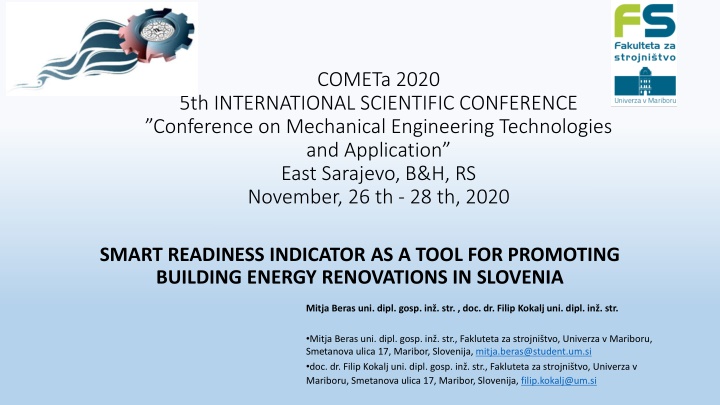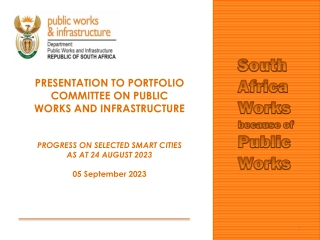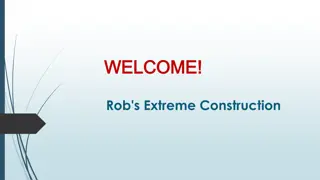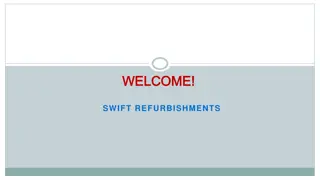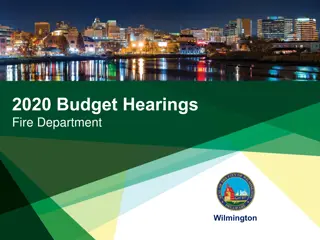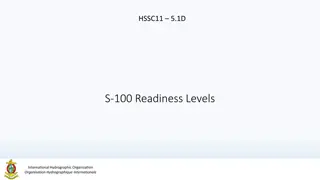Smart Readiness Indicator as a Tool for Building Energy Renovations
Energy consumption of buildings represents a significant portion of primary energy usage in the EU. This paper discusses the importance of the Smart Readiness Indicator (SRI) in promoting building energy renovations in Slovenia, addressing challenges on both the demand and supply sides. The SRI categorizes various building properties to assess energy performance, emphasizing the need for a transition to a low-carbon society through intelligent energy systems.
Download Presentation

Please find below an Image/Link to download the presentation.
The content on the website is provided AS IS for your information and personal use only. It may not be sold, licensed, or shared on other websites without obtaining consent from the author.If you encounter any issues during the download, it is possible that the publisher has removed the file from their server.
You are allowed to download the files provided on this website for personal or commercial use, subject to the condition that they are used lawfully. All files are the property of their respective owners.
The content on the website is provided AS IS for your information and personal use only. It may not be sold, licensed, or shared on other websites without obtaining consent from the author.
E N D
Presentation Transcript
COMETa 2020 5th INTERNATIONAL SCIENTIFIC CONFERENCE Conference on Mechanical Engineering Technologies and Application East Sarajevo, B&H, RS November, 26 th - 28 th, 2020 SMART READINESS INDICATOR AS A TOOL FOR PROMOTING BUILDING ENERGY RENOVATIONS IN SLOVENIA Mitja Beras uni. dipl. gosp. in . str. , doc. dr. Filip Kokalj uni. dipl. in . str. Mitja Beras uni. dipl. gosp. in . str., Fakluteta za strojni tvo, Univerza v Mariboru, Smetanova ulica 17, Maribor, Slovenija, mitja.beras@student.um.si doc. dr. Filip Kokalj uni. dipl. gosp. in . str., Fakluteta za strojni tvo, Univerza v Mariboru, Smetanova ulica 17, Maribor, Slovenija, filip.kokalj@um.si
Energy consumption of buildings represents approximately 40% of primary energy consumption in the European Union [1]. The existing building stock is a sector that has the greatest potential for achieving energy savings. Energy Efficiency Directive requires Member States to develop a long-term strategy to encourage investments in the renovation of the national building stock to increase the renovation rate in buildings.
Smart Readiness Indicator (SRI) The implementation is left to the individual Member states Make the transition into a low-carbon society Buildings must play an active role within an intelligent energy system.
Figure 1: Trends in GHG emissions (A) and the share of RES (B) in buildings in the period 2005-2017 and the projected course until 2050. [1] Source: Ministry of Infrastructure of Slovenia, Long-term strategy for energy renovation of buildings until 2050, 2020.
The Directive 2012/27/EU on energy performance of the buildings (EPBD) proposes a new categorization of buildings List of properties that are evaluated in the process of calculation the SRI is: heating domestic hot water cooling mechanical ventilation lighting dynamic building envelope energy generation demand side management electric vehicle charging monitoring and control [3]
CHALLENGES OF BUILDINGS ENERGY RENEWALS IN SLOVENIA On the demand side: poor user awareness, low economic motivation, limited possibility of carrying out a complete renovation of buildings, lack of competencies and professionally trained own staff etc. On the supply side: fragmentation of the construction sector demanding procurement procedures barriers to the widespread introduction of energy contracting uncertainty related to the legislative framework method of assessing profitability.[1] etc.
BENEFITS OF SRI A holistic approach The SRI could force a holistic approach to how buildings energy renovation projects are done. Good Smart Systems Readiness Indicator good design proper implementation working properly Market demand for good and proven, energy-efficient solutions. A dynamic indicator, opposite to Energy performance certificates (static) Promoting on-site energy generation The vision is that buildings will become producers of electricity
CONCLUSION The probability of meeting national energy goals and commitments would be with SRI much higher A lot of work needs to be done in the field of education of investors and decision makers Ultimate-goal, an energy-efficient real estate fund - > meeting the goals will have many multiplier effects, from new jobs, reduced energy consumption to higher productivity. Dependence on imported energy will be reduced Whole life-cycle approach
REFERENCES [1] Ministrstvo za infrastrukto Slovenije, Dolgoro na strategija energetske prenove stavb do leta 2050, 2020. [2] E. Parlament svet and E. Unije, DIREKTIVA (EU) 2018/844 EVROPSKEGA PARLAMENTA IN SVETA z dne 30. maja 2018 o spremembi Direktive 2010/31/EU o energetski u inkovitosti stavb in Direktive 2012/27/EU o energetski u inkovitosti(EPBD), vol. 2018, pp. 75 91, 2018. [3] N. Surmeli-Anac and A. H. Hermelink, The Smart Readiness Indicator: A potential, forward-looking Energy Performance Certificate complement?, ECOFYS, A naigant Co., no. May, 2018. [4] E. Parlamentsvet and E. Unije, Direktiva o energetski u inkovitosti stavb 2018 (EPBD), vol. 2018, pp. 75 91, 2018. [5] O. Omar, Intelligent building, definitions, factors and evaluation criteria of selection, Alexandria Eng. J., vol. 57, no. 4, pp. 2903 2910, 2018. [6] Y. Li, S. Kubicki, A. Guerriero, and Y. Rezgui, Review of building energy performance certification schemes towards future improvement, Renew. Sustain. Energy Rev., vol. 113, Oct. 2019. [7] T. M rzinger and D. sterreicher, Supporting the smart readiness indicator-A methodology to integrate a quantitative assessment of the load shifting potential of smart buildings, Energies, vol. 12, no. 10, 2019. [8] E. Janhunen, L. Pulkka, A. S yn joki, and S. Junnila, Applicability of the smart readiness indicator for cold climate countries, Buildings, vol. 9, no. 4, 2019. [9] E. Markoska, N. Jakica, S. Lazarova-Molnar, and M. K. Kragh, Assessment of Building Intelligence Requirements for Real Time Performance Testing in Smart Buildings, 2019 4th Int. Conf. Smart Sustain. Technol. Split. 2019, 2019. [10] I. L. O. Komisije, PRIPORO ILO KOMISIJE (EU) 2019/1019 z dne 7. junija 2019 o posodobitvi stavb, no. 2014, pp. 70 128, 2019.
